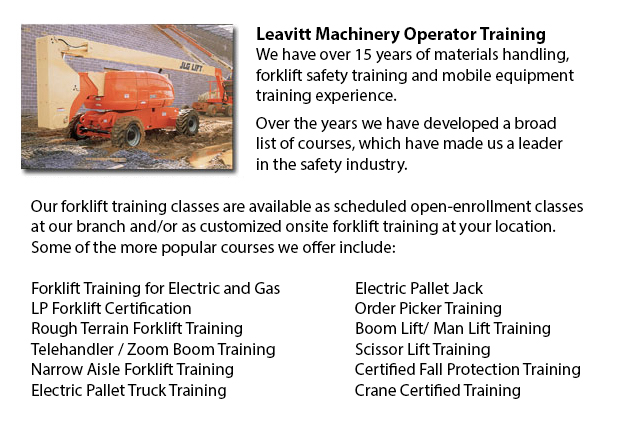
Prince Albert Aerial Boom Lift Training - Aerial Boom Lift Training is necessary for anyone who operates, supervises or works near boom lifts. This kind of aerial lift or aerial work platform is for lifting people, materials and tools in projects requiring a long reach. They are generally used to access utility lines and other above ground job-sites. There are different types of aerial booms lifts, like for instance articulating boom lifts, extension boom lifts and cherry pickers. There are two kinds of boom lift: "knuckle" and "telescopic".
Boom lift training is important and normally involves the fundamental safety, operations and equipment issues. Workers are required while working with mobile machinery to understand the rules, dangers, and safe work practices. Training program materials provide an introduction to the terminology, applications, concepts and skills essential for employees to obtain experience in boom lift operation. The material is aimed at safety experts, workers and equipment operators.
For your business requirements, this training is educational, adaptive and cost-effective and will help your workplace become safer and more effective, allowing for higher levels of production. Less workplace accidents occur in workplaces with strict safety policies. All equipment operators must be trained and assessed. They need knowledge of current safety standards. They have to understand and follow guidelines set forth by the local governing authorities and their employer.
It is the employer's responsibility to make sure that workers who should utilize boom lifts are trained in their safe use. Every different kind of workplace equipment requires its own machine operator certification. Certifications are available for aerial work platforms, articulating booms, scissor lifts, industrial forklift trucks, etc. Fully trained employees work more efficiently and effectively than untrained workers, who need more supervision. Proper instruction and training saves resources in the long run.
Training is the best prevention for the primary reasons for workplace fatalities: falls, electrocutions and collapses or tip overs. Aside from training, the best way to avoid workplace accidents is to operate and maintain aerial work platforms based on the instructions of the manufacturer. Allow for the combined weight of the tools, materials and the worker when following load limits. Never override electrical, hydraulic or mechanical safety devices. Employees should be securely held inside the basket using a body harness or restraining belt with a lanyard attached. Do not move lift machine while workers are on the elevated platform. Workers must take care not to position themselves between the basket rails and beams or joists in order to prevent being crushed. Energized overhead power lines should be at least 10 feet away from the lift machine. It is suggested that workers always assume wires and power lines might be energized, even if they are down or seem to be insulated. If working on an incline, set brakes and use wheel chocks.
-
Prince Albert Forklift Training Courses
Prince Albert Forklift Training Courses - When forklift operator safety training is tailored for illiteracy, training time is lessened by 50 percent. Lift-truck operator driver safety training evaluation, train the trainer and forklift training certi... More -
Prince Albert Heavy Equipment Training
Prince Albert Heavy Equipment Training - The two most common kinds of heavy equipment training are classed into the categories of equipment; equipment which is fashioned with rubber tires or those with tracks. The tracked vehicle are heavy duty machi... More -
Prince Albert Order Picker License
Prince Albert Order Picker License - Order preparation operation or order picking as it is more usually known is a method utilized within warehouse operations and comprises staff called order pickers. The order picker's duty is to take and collect ar... More -
Operator Safety Training, Re-Qualification Training, In-House Instructor Training in Prince Albert
Used in nearly all warehouse operations, boat yards or industrial construction sites, the lift truck is a very important part to be able to help raise and transfer cargo. The reach feature of a lift truck can help improve the applications which the f... More -
Prince Albert Overhead Crane Certification
Prince Albert Overhead Crane Certification - The overhead crane training certification program is designed to be effective with all those participating regardless of language or literacy restrictions. The course has two parts: a practical training se... More -
Prince Albert Heavy Equipment Training Programs
Prince Albert Heavy Equipment Training Programs - There are different types of equipment that are ready to be utilized at any given time on a construction site. These equipment require mechanics to be able to complete the maintenance tasks, operators... More -
Prince Albert Crane Operator Certification
Prince Albert Crane Operator Certification - The process to allow individuals to operate specific kinds of cranes is to take crane operator certification training to be given certification. The certification process consists of classroom learning, ha... More -
Prince Albert Crane Safety Training
Prince Albert Crane Safety Training - Both crane driver as well as their employers should know all the possible issues associated to the use of an overhead crane. All over North America, there is legislation that provides regulation for the safe oper... More

Forklift Certification Prince Albert
TOLL FREE: 1-888-254-6157
Prince Albert, Saskatchewan
forkliftcertificationprincealbert.com
Email Us
About Us


